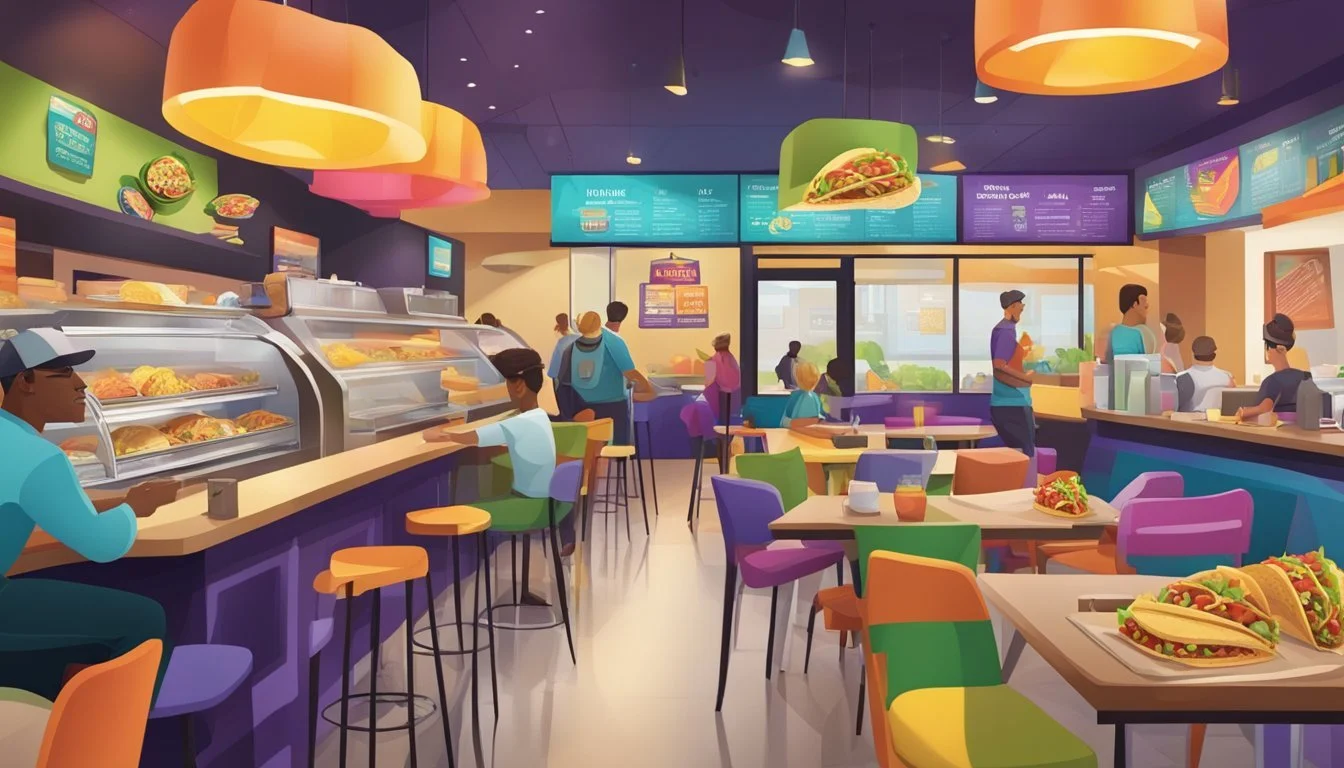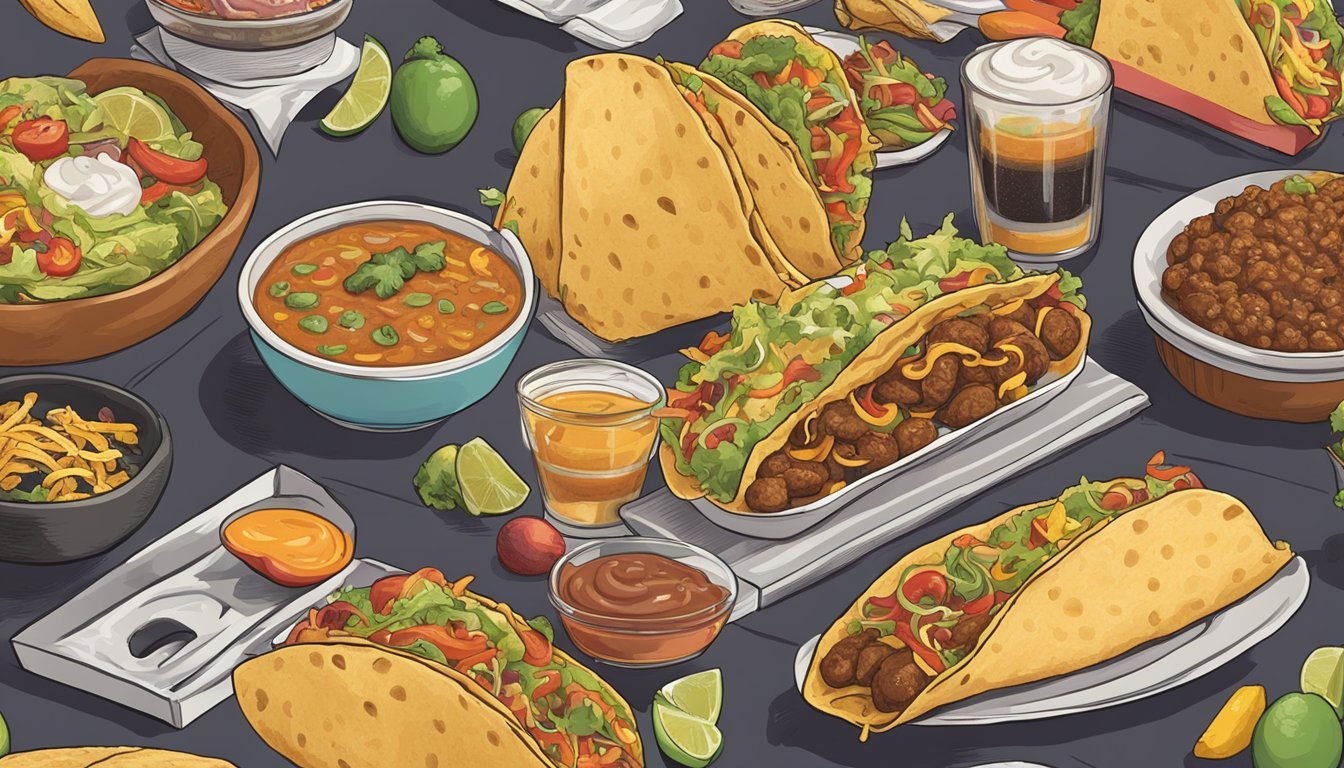Is Taco Bell Authentic Mexican Food?
Unpacking the Fast Food Take on Tradition
Discover > Texas Beyond The Lone Star State > Is Taco Bell Authentic Mexican Food?
As debate swirls around the authenticity of international cuisine served by global fast-food chains, Taco Bell often lands at the center of discussions about Mexican food. (What wine goes well with Mexican food?) Established in California, Taco Bell has grown into an international phenomenon, marketing its Mexican-inspired Taco Bell menu to a broad demographic. While its offerings include tacos, burritos, and quesadillas, which are staples of traditional Mexican cuisine, these items have been adapted to suit a mainstream audience that may not be seeking an authentic Mexican food.
Mexican food is renowned for its rich flavors, regional diversity, and cultural significance, elements that are often nurtured over generations and are intrinsic to the identity of Mexican culinary practices. Authentic Mexican food includes a wide range of ingredients and dishes that vary greatly by region, reflecting the country's complex history and geographic landscapes. Critics argue that the Taco Bell menu doesn't quite adhere to these traditional aspects, instead presenting a modified Taco Bell version tailored to a different palate.
Taco Bell's approach is characterized by its adjustments in flavor profiles and ingredient selection to appeal to a mass audience. With its Americanized take, the Taco Bell chain simplifies and alters the traditional dishes, which raises the question of whether it should be classified as an authentic Mexican food restaurant. In answering this, one must consider the attributes that define authenticity in cuisine and how much deviation from the original source is acceptable by Taco Bell before a dish becomes a mere inspiration rather than a faithful representation.
Historical Context
In exploring Taco Bell's relation to authentic Mexican food, it is important to understand the origins of Taco Bell , the evolution of Mexican food within the United States, and how Tex-Mex has become differentiated from traditional Mexican dishes.
Origins of Taco Bell
Taco Bell opened in Downey, California, in 1962. Glen Bell opened the first restaurant after previously owning a hot dog stand in San Bernardino. Glen Bell is not Mexican, but he was inspired by the Mexican food restaurants in his area. The first Taco Bell opened with food he created, designed with the American palate in mind, offering a simplified version of Mexican-inspired dishes.
More recently, Taco Bell revamped their corporate image in 2016 with an expensive campaign to evolve the Taco Bell brand identity.
Mexican Cuisine Evolution
Mexican food in the United States has transformed since the days of the Aztecs and Spanish colonization, mixing indigenous and European influences. As Mexican culture integrated with American lifestyle, the country and culinary traditions evolved to accommodate new tastes and ingredients, giving rise to what many consider Tex-Mex cuisine rather than authentic Mexican food.
Tex-Mex vs. Authentic Mexican Cuisine
Authentic Mexican food is rich in variety, stemming from different regions of Mexico, each with its own unique dishes and flavors. Tex-Mex, on the other hand, is a regional American cuisine originating from the Mexican-American communities of Texas. It blends Mexican and American elements to suit local tastes and often features heavy use of cheese, meats, and spices that are not typically found in Mexico's traditional recipes.
Analysis of the Taco Bell Menu
The Taco Bell menu features a variety of offerings which draw inspiration from Mexican food, yet are adapted to suit a wider audience, notably aligning with American tastes. Here, we scrutinize the Taco Bell items served, their ingredients, and how Taco Bell stands against traditional Mexican dishes found in typical Mexican restaurants.
The Taco Bell Signature Offerings
The menu at Taco Bell is characterized by its Doritos (how long do doritos last?) Locos Tacos, a fusion of a traditional taco with a Doritos-flavored tortilla shell. Other mainstream items include nachos, tortillas, several burrito including a Fiesta Burrito, a Beefy Fritos (how long do fritos last?) Burrito and an assortment of tacos, such as taco tia,
the Doritos Locos Tacos, that incorporate a variety of meats such as beef and chicken but French Fries as well. Notably absent at Taco Bell are deeper traditional dishes like tamales, enchiladas, or chiles en nogada.
Ingredients and Recipes
Key ingredients used in Taco Bell are cheese, tomatoes, onions, and cilantro, which are common in Mexican food, yet the spices used lean towards mild rather than spicy, lacking the full spectrum of authentic Mexican spicing including cumin and chiles. The Taco Bell recipes are designed for consistency and speed of service, differing significantly from the intricate methodologies found in a traditional Mexican restaurant.
Comparison with Traditional Mexican Dishes
In comparison, traditional Mexican dishes like cochinita pibil, a slow-roasted pork dish, and hard shell tacos complete with fresh vegetables and a specific balance of spices, showcase the rich complexity and regional varieties of authentic taco recipes. The Taco Bell adaptations forgo this authentic taco styling, favoring safer, more accessible flavors, such as their use of Taco Bell mole sauce, which is simplified and less nuanced than traditional versions. The presence of tostadas and beef in their menu does reflect common Mexican staples, yet the Taco Bell preparation diverges from tradition.
Cultural Impact and Perceptions
From the first Taco Bell to its rise as a powerhouse in the fast-food industry showcases a cultural phenomenon rather than an accurate portrayal of a traditional Mexican restaurant. The Taco Bell brand influence and the reception of its products have varied across communities and regions.
Taco Bell in the Mexican Community
In the Mexican community, Taco Bell often finds itself at the center of a debate about authenticity. Mexicans and those with close ties to traditional Mexican culture tend to view Taco Bell's menu as Mexican-inspired rather than an authentic Mexican restaurant, due to its substantial adaptation to American tastes. Taco Bell is known for its fusion approach, merging what is perceived as Mexican-style food with American fast food elements.
Popularity: Despite debates on its Mexican restaurant authenticity, Taco Bell remains popular for its convenience and taste, offering a unique take on Mexican cuisine elements and often touted as the best Mexican restaurant.
Cultural Response: The concept of what's genuinely 'Mexican' varies widely even within Mexico due to diverse regional adaptations. However, the consensus is that Taco Bell serves Americanised versions of Mexican dishes, which might share Taco Bell Mexican names but differ significantly from authentic Mexican restaurant recipes.
Customer Experience and Popularity
Each Mexican restaurant owned by Taco Bell, is recognized for its quick service and affordable prices, has solidified its position in the fast food industry as the best Mexican restaurant. Its popularity stems not just from its menu, but also from its strategic approach towards marketing, convenience, and a strong understanding of its customer base.
Taco Bell Affordability and Convenience
Taco Bell operates as a fast food chain that offers fast and affordable Mexican-inspired cuisine, tailored to the American palate with dishes such as the Doritos Locos Tacos. Customers appreciate the cheap pricing that does not compromise on service speed. This combination of low cost and convenience has played a key role in the chain's widespread appeal across the U.S.
Affordability: Most menu items are priced to attract budget-conscious consumers.
Convenience: Numerous locations and quick service define Taco Bell's attraction.
Taco Bell Marketing and Social Media Presence
The Taco Bell brand harnesses the power of marketing and social media platforms like Twitter and Instagram to connect with customers. Ad campaigns often feature humorous elements, such as the iconic Chihuahua mascot, which have historically enhanced the chain's popularity. Similarly, social media campaigns aim to engage with a wide audience, fostering a sense of community among Taco Bell enthusiasts.
Twitter: Regular updates and customer interaction.
Instagram: Visual content showcasing new items and promotions.
Taco Bell Demographics and Customer Loyalty
Taco Bell has captivated various demographics, particularly younger customers, by positioning itself as a culturally relevant brand. Its commitment to constantly evolving menus resonates with customers who value innovation alongside affordability. As a result, the chain enjoys a loyal customer base, further cementing its fast food market status.
Younger Customers: Targeted through menu innovation and digital engagement.
Loyalty: Reinforced by a consistent brand experience and value propositions.
Health, Nutrition, and Sustainability
When evaluating Taco Bell in the context of an authentic Mexican restaurant, it is also essential to scrutinize the health and nutritional aspects of its menu along with the brand's commitment to sustainability. In addition, Taco Bell's vegetarian and vegan menu items cater to diverse dietary preferences.
Nutritional Analysis of the Menu
Taco Bell's menu provides a variety of items that can be modified to different diets. Salads and items rich in vegetables can be healthier choices for those seeking more nutrition in their meals. However, patrons should be aware that some menu choices may be high in calories, sodium, and saturated fats. Taco Bell provides nutritional information on their website, helping customers to make informed choices.
Sustainability Efforts
Taco Bell has undertaken several sustainability initiatives to decrease its environmental impact. Reducing energy consumption, waste, and their overall carbon footprint have all been targeted. The Taco Bell introduction of a sauce packet recycling program demonstrates their willingness to engage both the company and customers in sustainability.
Vegetarian and Vegan Options
The menu at Taco Bell is adaptable to both vegetarian and vegan dietary patterns, offering a range of plant-based ingredients. With foods labeled accordingly, those who abstain from meat can select from Taco Bell menu items such as:
Vegetarian: Items that may contain eggs, dairy, or other non-meat animal derivatives.
Vegan: Food that excludes all animal products, accommodating those who avoid ingredients like cheese and sour cream.
Furthermore, the Taco Bell Mexican restaurant has acknowledged the growing demand for plant-based eating and responded with an increasing number of options that capitalize on the ubiquity of this trend in the fast-food industry.
Taco Bell Comparative Analysis with Other Chains
In understanding Taco Bell's authenticity in the Mexican restaurant, it's crucial to compare it with other chains that offer Mexican-inspired food.
Taco Bell vs. Other Mexican Restaurants
Taco Bell is known for its Mexican-inspired menu, featuring items like tacos and the beefy fritos burrito. In comparison, Chipotle focuses on a more customizable dining experience, regularly branding itself as offering food with integrity with an emphasis on fresh, higher-quality ingredients. Another competitor, Qdoba, also provides a similar build-your-own meal experience but differs in offering flavors that may be considered closer to authentic Mexican tastes.
Ingredient Authenticity: Taco Bell uses Americanized toppings like shredded cheese, while Chipotle and Qdoba use ingredients like cilantro-lime rice that align more closely with traditional Mexican flavors.
Menu Variety: Del Taco, another fast-food chain, competes with Taco Bell by offering a larger variety of Mexican items and American favorites like burgers, unlike Taco Bell's more focused Tex-Mex selection.
Taco Bell's Place in the Fast Food Industry
Taco Bell stands out in the fast food industry by maintaining a strong Taco Bell brand identity tied to Mexican restaurants. There are now Taco Bell open restaurants throughout the US and internationally and the chain is often quoted as the best Mexican restaurant. As a subsidiary of Yum! Brands, which also operates Pizza Hut, it benefits from shared marketing and operational strategies. While Taco Bell leads in branding, sales, and market presence, authenticity in a culinary sense is often less of a priority across the board for fast-food chains.
Sales: Taco Bell often outperforms its direct competitors in annual sales.
Market Presence: Taco Bell operates more locations globally compared to specialty chains like Qdoba or regional ones like Del Taco and Taco Land.
Brand Perception: Taco Bell's aggressive marketing campaigns and innovative menu items keep Taco Bell at the forefront of consumers' minds as a go-to for quick and affordable Mexican-themed fast food.
Conclusion
Sometimes quoted as the best Mexican restaurant, Taco Bell represents a fusion more reflective of American tastes than real Mexican food. The Taco Bell menu consists of items such as the taco, burritos, and nachos which borrow from Mexican culinary culture, but these offerings undergo significant adaptation for mass appeal under the Taco Bell brand.
Taco Bell Authenticity in Food:
Authentic Mexican food encompasses a rich variety of flavors, techniques, and fresh ingredients, deeply rooted in regional traditions of Mexico City.
Taco Bell's menu largely deviates from these traditions by modifying recipes and using ingredients that suit a broader customer base, focusing on convenience rather than real Mexican food.
Taco Bell Customer Experience:
The experience at Taco Bell is geared towards fast service and consistent taste that caters to a fast-food audience.
Traditional Mexican dining emphasizes an authentic atmosphere and the cultural experience of its cuisine, which Taco Bell does not claim to provide.
Since the first Taco Bell opened decoding the essence of the Taco Bell's menu shows it is more accurately described as Tex-Mex, a regional cuisine that blends American and Mexican elements, such as Nacho Fries or French Fries. While Taco Bell introduces its customers to flavors that are inspired by Mexican market dishes, the authenticity of these flavors is adapted to suit a fast-food experience.
Those seeking an authentic Mexican dining experience would likely explore traditional eateries that specialize in regional dishes of Mexico, which offer a different spectrum of tastes and dining experiences than what one would find at a Glen Bell Taco Bell.





